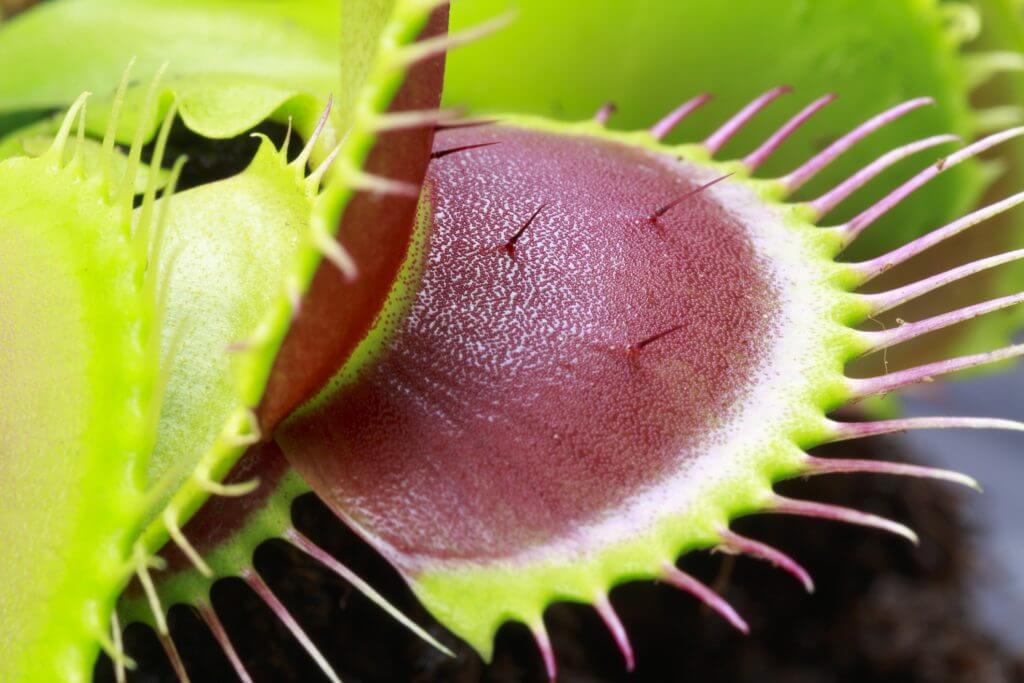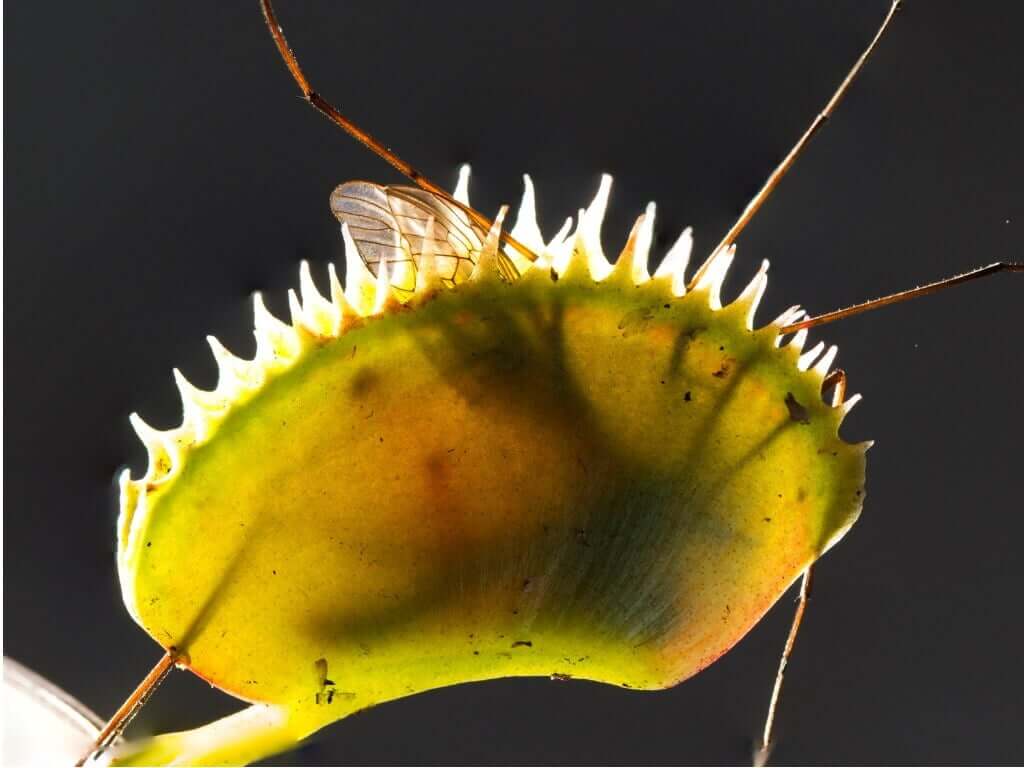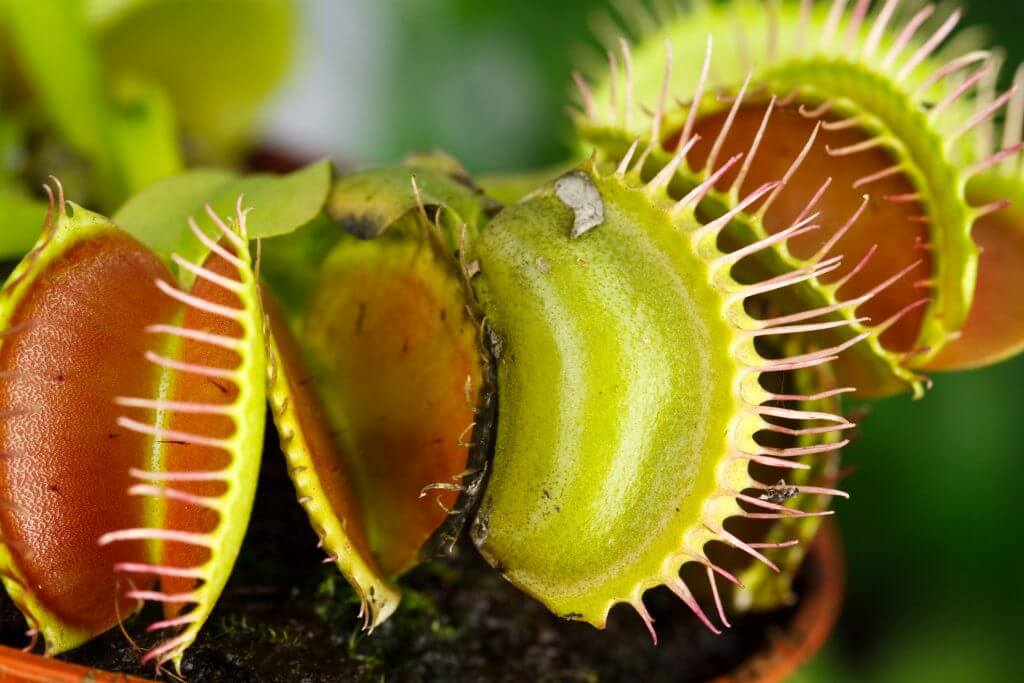If you feel like your plant collection needs more diversity, you may want to consider the Venus flytrap.
Some people may find this plant weird, but it is an interesting addition to your garden or windowsill.

The Basics of Venus Flytrap
Venus flytrap or Dionaea muscipula is a popular carnivorous plant native to the East Coast of the United States, particularly North Carolina and South Carolina.
This carnivorous plant is most recognisable for its insect-catching leaves that close when triggered by prey.
Structure of the Venus Flytrap
The structure of the Venus flytrap plant is a rosette of four (4) to seven (7) leaves that grow from a short, subterranean (under the soil), bulb-like stem.
This carnivorous plant grows a group of small and white flowers from a stem of about 8 to 12 inches (20 to 30 cm) long.
The leaves of the Venus flytrap are about 3 to 6 inches (8 to 15 cm) long and have two parts: a flat and heart-shaped petiole which is capable of photosynthesis, and two terminal lobes attached at the midrib.
The pair of terminal lobes form the trap. This trap is the true leaf, and it secretes mucilage from the edges.


How Venus Flytrap Catches Prey
The leaf of the Venus flytrap quickly shuts when prey is detected. The upper surface of the terminal lobes has three hair-like trichomes.
These trichomes are so sensitive that it enables the plant to distinguish if the trigger was from prey or a non-living thing like a water droplet.
For the Venus flytrap to shut its leaf, two of the trichomes must be triggered by the prey within 20 seconds from the first, or a single trichome triggered again immediately following the first trigger.
When it shuts its leaf (which happens very rapidly), the prey is trapped inside and will not be able to escape.
The more the prey tries to wiggle and move to escape, the tighter the leaf of the Venus flytrap will shut. The leaves will close, and it will be airtight.


How Venus Flytrap Digests Its Prey
The Venus flytrap’s leaf will be airtight and start producing digestive enzymes when the trigger hairs are stimulated at least five (5) times more from the time it shuts. This happens when the prey moves around as it tries to escape.
Digestion of the Venus flytrap’s prey will take about ten (10) days. After full digestion, the trap or leaf opens again to reveal the husk of undigested insect parts.


Planting Your Venus Flytrap
Like all carnivorous plants, the Venus flytrap needs to be planted in a low-nutrient and boggy medium.
You can use a planting medium mixture of equal amounts of peat moss and garden sand or gravel. Do not plant your Venus flytrap in nutrient-rich potting soil.
If you want to grow a Venus flytrap from seed, it will take about four (4) to five (5) years to reach maturity. You can also get them from nurseries or garden centres near you or online.
Place your Venus flytrap in a position with direct sunlight. Ideally, place them where they have full sun for 10 to 12 hours a day.
You can plant them in containers, especially if you have other plants in your garden, because your soil may be too rich in nutrients.
Caring for Your Venus Flytrap
Watering Your Venus Flytrap
Your Venus flytrap needs to be kept constantly moist. Water it every few days.
You may need to water Venus flytrap every day during hot and dry weather.
However, do not overwater. Check to see if the soil of your Venus flytrap is moist underneath the top layer.
Use distilled or rainwater to water your Venus flytrap. Do not use tap or filtered drinking water as it could be poisonous for them.
Tap or filtered water may make your medium too alkaline for the Venus flytrap. Keep in mind that they prefer acidic soil.
Light and Position for Your Venus Flytrap
Venus flytrap ideally needs about 10 to 12 hours of full sun every day. They can survive in partial shade or fewer hours of direct sun, but they will not grow as well as under full sun.
During summer, however, you can keep them in partial shade if you get really hot summers. This is to ensure that your Venus flytrap does not dry out.
Feeding and Fertilising Venus Flytrap
Resist the temptation to feed insects to your Venus flytrap. They will get their own prey when they need it, especially if they are outdoors.
Do not fertilise your Venus flytrap either, because they thrive in low-nutrient soil.
Taking Care of Your Venus Flytrap During Dormancy
You need to remember that Venus flytraps need their winter dormancy.
If you keep them indoors, take them outside to cooler places or even the greenhouse so that they can go through their dormancy period.
Keep your Venus flytrap cool at temperatures but not below freezing—ideally between 32 to 55°F (0 to 11°C) during dormancy.
Keep the soil of your Venus flytrap damp even during this dormancy period.
During this time, your Venus flytrap should get less sun, too.
Pruning Your Venus Flytrap
Deadhead your Venus flytrap and remove dead or dying leaves.
If you notice leaves that seem to look dry, wilted, or discoloured, remove them immediately as these unhealthy leaves will make your plant susceptible to diseases.
Common Problems with Venus Flytrap
It may be counterintuitive that a carnivorous plant such as a Venus flytrap can get pests, but they do.
Venus flytraps are not susceptible to most pests, but smaller plant pests such as aphids and fungus gnats may cause issues.


Aphids
Aphids may be too tiny for the Venus flytrap to catch, and they usually stay under the leaves. Aphids will cause your plants leaves to distort at the crown. Although aphids may unlikely kill your Venus flytrap, they are a nuisance.
To remove aphids from your Venus flytrap, submerge the plant in water for several days (about 2 to 3 days). Repeat this treatment in another week.
You can also use horticultural oils or insecticidal soaps against aphids.
Fungus Gnats
Adult fungus gnats, like aphids, are a nuisance for the Venus flytrap. However, the larvae of the fungus gnats can cause damage, especially to younger plants.
The larvae of the fungus gnat will burrow into the Venus flytrap’s stems. These larvae also damage the leaves as they feed on them.
Grey Mould
Venus flytraps are usually not susceptible to bacterial or fungal diseases. However, one particular fungus may infect and damage your plant.
Grey mould or Botrytis cinerea is a necrotrophic (causes rotting) fungus that can affect your Venus flytrap. This disease will kill parts of the plant and eventually infect other parts and kill your Venus flytrap.
The grey mould will appear on your Venus flytrap’s leaves looking like the mould you could see on old bread.
Remove the infected Venus flytrap leaves as soon as you notice the mould.
Constantly moist leaves can make your Venus flytrap susceptible to this fungus.
To prevent this, remove dead leaves as soon as possible, and keep your Venus flytrap in a warm place with good circulation.
Keep your Venus flytrap’s leaves dry at all times.
[elementor-template id=”4604″]
[elementor-template id=”6387″]
